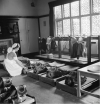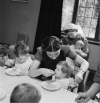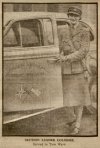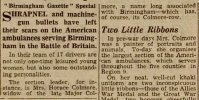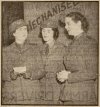-
Welcome to this forum . We are a worldwide group with a common interest in Birmingham and its history. While here, please follow a few simple rules. We ask that you respect other members, thank those who have helped you and please keep your contributions on-topic with the thread.
We do hope you enjoy your visit. BHF Admin Team
You are using an out of date browser. It may not display this or other websites correctly.
You should upgrade or use an alternative browser.
You should upgrade or use an alternative browser.
Women war workers of Birmingham
- Thread starter Vivienne14
- Start date
Mark Tooze
master brummie
To the first world war now, and the highly dangerous job of working in the Birmingham munitions industry. Most have no captions from the IWM website as I guess this info was highly classified at the time:-

1918
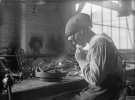
Aeroplane Frame Tug Welding 1918

Turning Gas Mask Angle Tubes 1918

Camoflaguaging Gun Carriages 1918

Turning Aluminum Shell Fuse Caps 1918

Steel Hardness Testing 1918
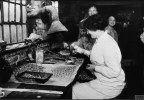
Priming Pin Tinning 1918

Welding Birmingham Technical School 1918
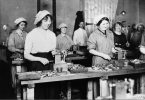
Tapping Friction Tubes 1918

Primer Plug Manufacture 1918

1918

Aeroplane Frame Tug Welding 1918

Turning Gas Mask Angle Tubes 1918

Camoflaguaging Gun Carriages 1918

Turning Aluminum Shell Fuse Caps 1918

Steel Hardness Testing 1918

Priming Pin Tinning 1918

Welding Birmingham Technical School 1918

Tapping Friction Tubes 1918

Primer Plug Manufacture 1918
Mark Tooze
master brummie
Some more under the same heading:-

Shell Weighing 1918

Soldering Cigarette Tins 1918

Shell Gauging 1918
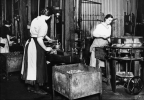
Shell Brass Plug Manufacture 1918

Priming Pin Sorting 1918 (what a belter of a job this must have been.....)

Copper Band Cut Gauging 1918

Gauging Fuse Manufacture 1918
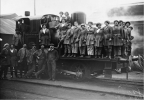
Munitions Factory Birmingham 1918

Mould Making Birmingham Technical School 1918
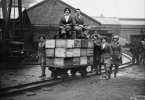
And finally in this section - the ultimate definition of "being laid back on the job" - TNT Factory Birmingham 1918

Shell Weighing 1918

Soldering Cigarette Tins 1918

Shell Gauging 1918

Shell Brass Plug Manufacture 1918

Priming Pin Sorting 1918 (what a belter of a job this must have been.....)

Copper Band Cut Gauging 1918

Gauging Fuse Manufacture 1918

Munitions Factory Birmingham 1918

Mould Making Birmingham Technical School 1918

And finally in this section - the ultimate definition of "being laid back on the job" - TNT Factory Birmingham 1918
Mark Tooze
master brummie
Now lets go to the Austin Motors Factory which, in 1918 was making aeroplanes for the war effort - again with lots of female labour:-

Fuselage Stitching

 Fun in the Carpentry Shop!!!
Fun in the Carpentry Shop!!!

Spray Painting

 Painting Distinction Markings
Painting Distinction Markings
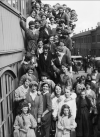


 Group photocalls!
Group photocalls!



 Airframe Manufacture
Airframe Manufacture

Canvas Doping
And - finally in this set - the ladies even helped to build the factory!!


Fuselage Stitching

 Fun in the Carpentry Shop!!!
Fun in the Carpentry Shop!!!
Spray Painting

 Painting Distinction Markings
Painting Distinction Markings


 Group photocalls!
Group photocalls!


 Airframe Manufacture
Airframe Manufacture
Canvas Doping
And - finally in this set - the ladies even helped to build the factory!!

Mark Tooze
master brummie
Mark Tooze
master brummie
Great photos Mark of women munitions workers in WW1. Many of these photos look like publicity material, everyone happy and clean. But the reality was a dangerous and dirty job.
I wondered if any of the photos were of the Wolseley factory when they made munitions, my grandmother worked there 1914 onwards.
I wondered if any of the photos were of the Wolseley factory when they made munitions, my grandmother worked there 1914 onwards.
totally agree viv...without the women workers the wars would not have been won...as you said their work was dirty and dangerous..no health and safety...one wrong move in the munitions factory and they were blown to bits...respectGreat photos Mark of women munitions workers in WW1. Many of these photos look like publicity material, everyone happy and clean. But the reality was a dangerous and dirty job.
lyn
Mark Tooze
master brummie
Hi Vivienne - posed shots - in most cases I think yes. Wolseley - not sure - as I said at the top because of the nature of the subject some do not have much detail on the captions. I have copied sets for Kynochs, Canal work, Railways, ATS recruitment and a munitions factory in Coventry which I will try to continue to post tonight. Also copied sets of visits from Montgomery and Churchill, loads of posters and many of bomb damage in Birmingham and Coventry which I will post onto the most appropriate threads. The IWM website looks like an absolute goldmine - I've hardly scratched its surface so far! Easily as good if not better than the Historic England and National Railway Museum websites!Great photos Mark of women munitions workers in WW1. Many of these photos look like publicity material, everyone happy and clean. But the reality was a dangerous and dirty job.
I wondered if any of the photos were of the Wolseley factory when they made munitions, my grandmother worked there 1914 onwards.
Last edited:
Not only dangers of being blown up, but look how close they were working to those leather belts driving the machines. Certainly no health and safety. When I worked at McKecknie Brothers in Ladywood in late 40s my uncle was the works photographer and had to take photographs of all accidents, many of them caused by the leather drive belts. Some very blood curdling incidents.
Richard Dye
master brummie
When I served my apprenticeship late 50’s early 60’s I would say 80% of our machines were belt driven. We were a machine tool company and had lots of machines. When you heard that “SNAP” of a belt letting go, you ducked down as low as you could go! I was lucky, many not so!Not only dangers of being blown up, but look how close they were working to those leather belts driving the machines. Certainly no health and safety. When I worked at McKecknie Brothers in Ladywood in late 40s my uncle was the works photographer and had to take photographs of all accidents, many of them caused by the leather drive belts. Some very blood curdling incidents.
Radiorails
master brummie
The younger girls appear to be school age or are recently left in many of these photographs.
yes alan aout 14 years old in a lot of casesThe younger girls appear to be school age or are recently left in many of these photographs.
lyn
Dinger
master brummie
You're just the calibre of worker we're looking for.Thats all for tonight folks - will try to post more tomorrow including an explanation of what the £$%& is about to happen to this poor girl.....View attachment 189211
thought this a good thread to post this video...brilliant footage
Mark Tooze
master brummie
OK - from last nights quiz question - so who and where is this?????Thats all for tonight folks - will try to post more tomorrow including an explanation of what the £$%& is about to happen to this poor girl.....View attachment 189211
No - it was not the latest act in the circus, but the Coventry Ordinance Works in 1917 (just over the border but close enough)!
The girl (who I assume was selected purely for her size) was being inserted into the barrel of a 15-inch naval gun presumably to clean its interior:-
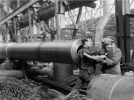
It looks like a damn tight fit - I know I would not get in there - ever.......

At least she had a bit more room (but not much.....) when she was also inserted into the other end!

This was a monster of a gun barrel - I will post more photos of it on another thread:-
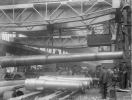
Lots of women were employed here in various roles - these ladies are fuse head packing:-
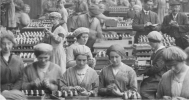
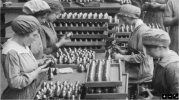




And these folk are fuse head machining:-

Mark Tooze
master brummie
Here is a puzzle - the captions all say "Great Central Railway Birmingham" - but the Great Central came nowhere near Birmingham from what I can research - Rugby or Leicester were about as close as it got according to this map from Wikipedia:- 
The only thing I can think of is that the locomotive was being serviced in Birmingham (you can see Great Central on one of the tenders, and also a building in the background that looks like it cound be Tyseley works) - I suppose in wartime they would have had to service anything they could - any thoughts anyone?
Anyway the photos are a damn good set and who am I to argue with the Imperial War Museum - so here we go - all dated 1918:-



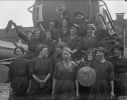



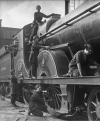

The only thing I can think of is that the locomotive was being serviced in Birmingham (you can see Great Central on one of the tenders, and also a building in the background that looks like it cound be Tyseley works) - I suppose in wartime they would have had to service anything they could - any thoughts anyone?
Anyway the photos are a damn good set and who am I to argue with the Imperial War Museum - so here we go - all dated 1918:-








Mark Tooze
master brummie
Now a random selection of female war workers all from the IWM website:-
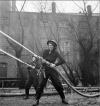
Fire Guard Boxfoldia Bournbrook 1943



Army Equipment Exhibition Birmingham City Centre 1944




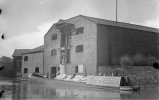
Female "Bargee" (think this is the correct term...) Tipton Green Cotterill Colliery Branch Birmingham Canal 1942


National Fire Service Training Centre Augustus Road 1942

Birmingham Toy Factory Worker 1918
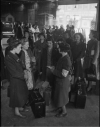
Female War Workers waiting to leave from New St Station on postings 1941

Fire Guard Boxfoldia Bournbrook 1943



Army Equipment Exhibition Birmingham City Centre 1944





Female "Bargee" (think this is the correct term...) Tipton Green Cotterill Colliery Branch Birmingham Canal 1942


National Fire Service Training Centre Augustus Road 1942

Birmingham Toy Factory Worker 1918

Female War Workers waiting to leave from New St Station on postings 1941
Richard Dye
master brummie
Great photos Mark! The B&W looks really great.........Here is a puzzle - the captions all say "Great Central Railway Birmingham" - but the Great Central came nowhere near Birmingham from what I can research - Rugby or Leicester were about as close as it got according to this map from Wikipedia:- View attachment 189255
The only thing I can think of is that the locomotive was being serviced in Birmingham (you can see Great Central on one of the tenders, and also a building in the background that looks like it cound be Tyseley works) - I suppose in wartime they would have had to service anything they could - any thoughts anyone?
Anyway the photos are a damn good set and who am I to argue with the Imperial War Museum - so here we go - all dated 1918:-
View attachment 189256
View attachment 189259
View attachment 189257
View attachment 189258
View attachment 189260
View attachment 189261
View attachment 189262
View attachment 189263
Mark Tooze
master brummie
And finally - a set of portraits of ATS Recruitment Staff in the Birmingham Recruitment Office in 1942 - most are from this office but some from places like Coventry, Dudley and Kidderminster:-


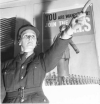

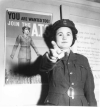


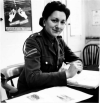

Once recruited and trained, ATS personnel performed such tasks as storewomen:-

And Ack-Ack gun operation! (this one is somewhere in Birmingham in 1943)










Once recruited and trained, ATS personnel performed such tasks as storewomen:-

And Ack-Ack gun operation! (this one is somewhere in Birmingham in 1943)

only just spotted your photo viv...nothing more annoying than having a photograph that shows our rellies but we dont know where they are..no idea what those boards are thoughThis is the Drews Lane munitions workers - taken about 1917. My grandmother (age 19) and her sister are on this photo, but not sure which ones. I've posted this before, but only just noticed the boards beneath the central man's legs. Are these items they were making ?
View attachment 189220
lyn
Radiorails
master brummie
The Great Central Railway locomotive featured above was probably one of many that were loaned briefly to other railways during WW2.






